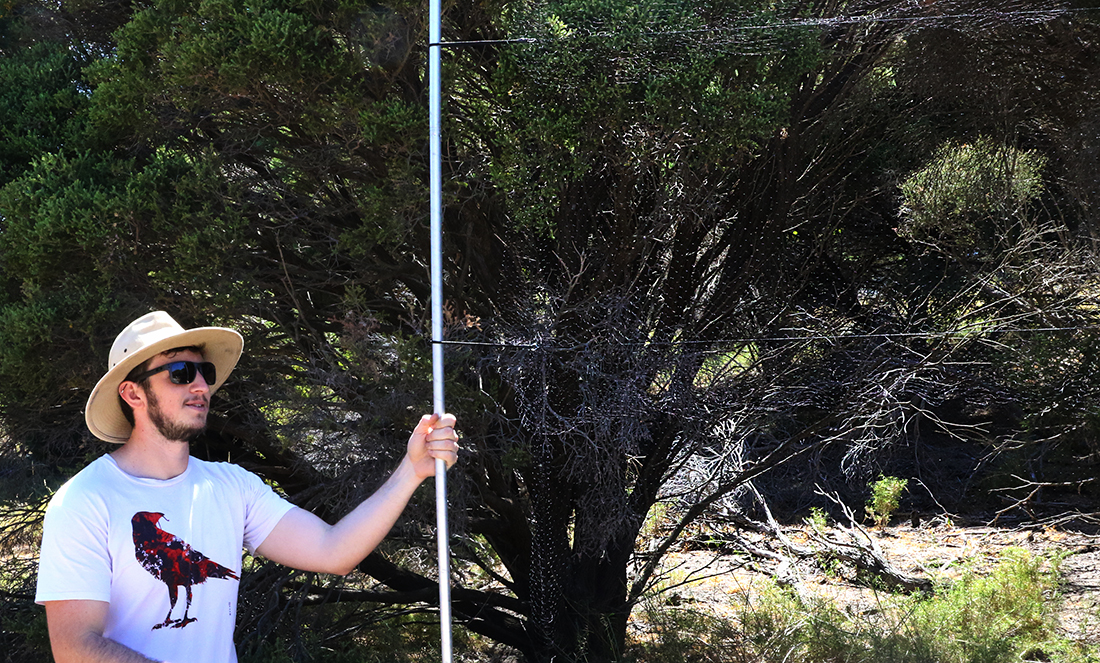Good guy Mother Nature has taken a few hits in the name of human advancement.
For people to have food to eat and places to live, nature has had to make way. Native animals have lost a lot of their natural habitat to clearing, degradation and disturbances.
Restoration promises to return damaged environments to their former glory. But can it deliver on those promises? To find out, ECU PhD student Floyd Holmes says you just have to ask the birds.

Birds of a feather flock together
It turns out Australian birds have a lot to say about their habitat, if you know how to listen. And that’s what Floyd aims to do in the surrounds of Rottnest Island’s woodlands.

With a keen eye and ear, he studies the behaviour of birds to determine the quality of habitat.
“I am looking at how birds behave in different habitat types and whether their behaviour is different in restored versus remnant habitat,” Floyd tells us.
“The main areas I’m looking at are feeding, territoriality and breeding behaviours.”
Behaviours like feeding or breeding in an area are like a tick of habitat approval from birds. They’re good indicators that the habitat can sustain a viable population.
Floyd’s bird of choice is the red-capped robin. The robin’s shocking tuft of red feathers on its head and belly make it easier to spot in the wild.
But in order to work out which bird is which, Floyd needs to get a bit more up close and personal.
A bird in the hand
Let’s say that, while walking around the bush, you see robins feeding 10 times. How can you tell if it was 10 different robins or a single rogue bird?
In the world of bird research—if you like it then you gotta put a ring on it.

“In the world of bird research—if you like it then you gotta put a ring on it.”
The process is called bird banding. It involves putting rings around birds’ legs to help identify them. But don’t be fooled—it’s a tricky process and requires specialist knowledge and training.
“Birds are incredibly fragile, so it’s necessary to be properly trained before you start handling them on your own,” says Floyd, an A-class bird bander.
To catch a bird for banding, Floyd sets up thin nets, called mist nets. They’re designed to look inconspicuous to their unsuspecting targets.

The nets are made up of folded pockets, so when a bird flies in, it slips safely into a pocket. It is then carefully extracted by a certified bird bander.
In Floyd’s case, when he catches a robin, he attaches a distinct split-coloured band to its leg. Each robin gets a different colour combination so Floyd can tell Harry from Larry.
If he captures a non-target bird, like a western gerygone, he still bands it with a metal band. This is to assist other research on the island.
“The primary purpose of bird banding for this project is to make the birds individually identifiable,” he explains.
“That way, I know when the birds move between sites, I know which birds are visiting which nests and I know which birds have fledglings. It also allows me to be sure I’m not counting the same bird twice.”

Once the birds are sporting their bright new bling, Floyd can gain a better understanding of the number of animals in an area and how they’re using their habitat.
If you build it, they will come
Most restoration operates roughly on the Field of Dreams hypothesis: “If you build it, they will come.”
In restoration, local flora are planted in the degraded area in hopes the fauna will follow. But it’s not well understood yet if plants alone are enough to bring back the animals.

Through his research, Floyd is hoping he can provide much-needed insight into better ways to restore habitats.
“This research will hopefully demonstrate the value of using animal behaviour in restoration assessments, as it can provide information about the habitat from the animal’s perspective,” he says.
“This is a small step in a long journey to better understanding how best to manage restoration projects and what to measure while monitoring them.”














